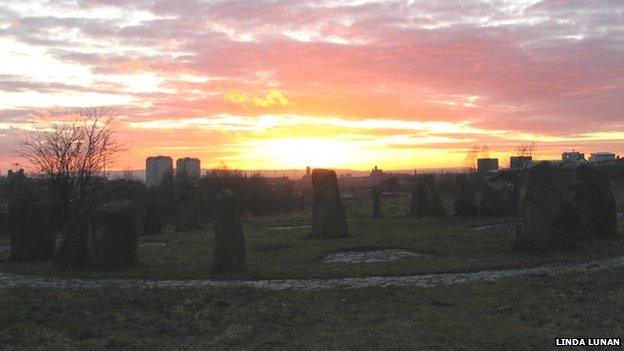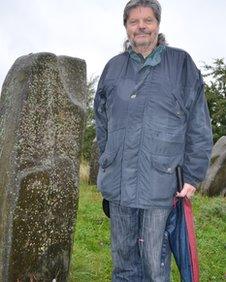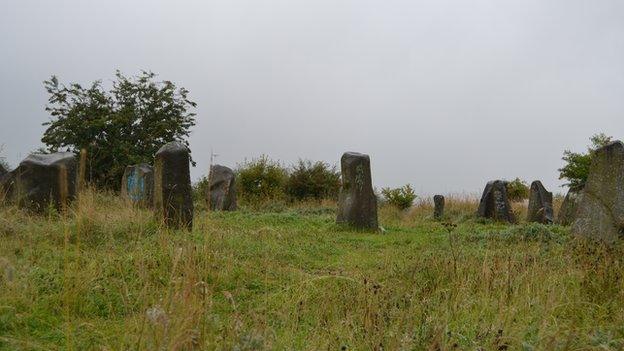70s Stonehenge - Sighthill stone circle under threat from planners
- Published

Sunset at the Sighthill stone circle
The phrase stone circle might well bring to mind somewhere like Stonehenge but it is probably not something you would expect to find in the Sighthill area of Glasgow. Its circle is not an ancient structure, it is just 34 years old, but its future is threatened by plans for development.
The autumn equinox, which marks the changing of the seasons, will see a small band of pagans and others gather at Sighthill's stone circle for what could be a final farewell.
With its remaining tower blocks still dominating the skyline and the constant background hum of the motorway, the site of a stone circle on top of a hill in Sighthill Park could be seen as a surprising one.

Duncan Lunan who designed and built the circle
It is said to be the first astronomically-aligned stone circle built in Britain for around 3,000 years.
"I'd walked from Buchanan bus station. I could hear birds singing, you could see butterflies and bees and I thought, this is a nice place and then the stones appeared over the hill," says David Horton-McGlone, a Glasgow pagan speaking about his first sight of the circle.
The stones themselves came from a quarry in Kilsyth and for some they have taken on a very special meaning.
"You felt you were going back in time to an ancient period where you might find a priest walking up there, a druidic person of some sort," continues Mr Horton-McGlone.
"You felt welcomed, you felt homely, the energy from the sun setting and it was just magical, so the stones just seem to create a vibe.
"You feel relaxed when you're within the stones and get away from daily life - the daily struggle."
The stones started out life more prosaically as part of a late-1970s job creation scheme.
The idea for the circle was adapted and developed from the winning entry to a schools competition and a number of sites around the city were considered before it was decided that the skyline at Sighthill made it the ideal place to build.
"We're standing here on the north side of the stone circle, over to the west we have the spire of Glasgow University through the mist," says Duncan Lunan, who led the original project.
"In the north, if it was clear, we'd have a beautiful view here of the Campsies." .

The 17 standing stones look part of the Glasgow landscape
The 17 standing stones now look very much part of the Glasgow landscape - some daubed in graffiti.
When they first arrived here in 1979, some of the stones were brought to the site by Royal Navy helicopter. Local schoolchildren were given the day off to watch and the whole event made news.
"Very shortly afterwards," continues Mr Lunan, "we were denounced in the House of Commons as an example of how worthless the jobs creation scheme was and how it would all be done away with because the new Tory government was going to restore full employment."
Phase two of the project was never completed and the spare stones still lie unused under a tree.
The circle is not just a curiosity, but was designed to be a real contribution to what was a very live debate about what the ancients knew about the stars.
Highly personal
Every feature in the circle can be found at some ancient site and Duncan Lunan says they wanted to explore the idea that if the Sighthill circle was able to function as an observatory in the modern-day, how were the old sites any different?
For others though, the stones are highly personal.
At the foot of the centre stone is a small cross and flowers to remember Lily Forbes, a local woman who loved the park.
When she died, aged 89, her family scattered her ashes there and her son still visits a few times a week.
"She just loved the place," says Jack Forbes of his mother.
"Two or three times a week I'm up here. I just get solitude and contentment, this is like a church to me.
"I come here and I pray and I talk to my mum. That's why I'm so broken-hearted about this place getting taken away."
There are plans for the whole area to change as part of a proposed regeneration scheme.
The council says part of that is to create a better quality and slightly bigger park than is there at present. The land that the stones sit on would drop by four metres and that means they may have to move.
Duncan Lunan says his understanding is that there is "no scope" for the circle to remain as it is.
The council adds that it has made a commitment to look at other options for the stones and a public consultation to look at their future use and location is planned.
If the stones themselves can be saved, Duncan Lunan says he would like to use them in a new project. Since a lot of the organised support has come from the druid and pagan communities he would like it to be something they felt at home with.
"It will be a great wrench when it goes," he says.
"There are lots of people for lots of different reasons to whom this circle means a great deal. If we can at least keep that spirit that will be good."
- Published5 May 2013
- Published2 June 2010